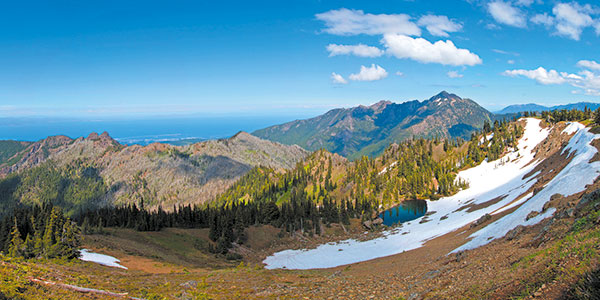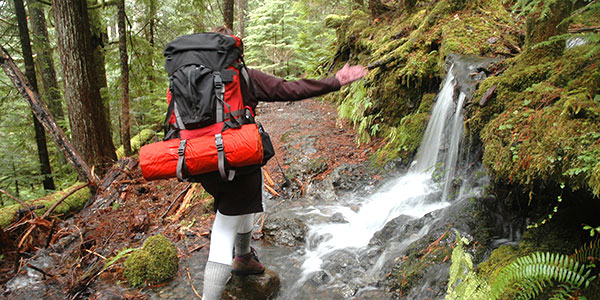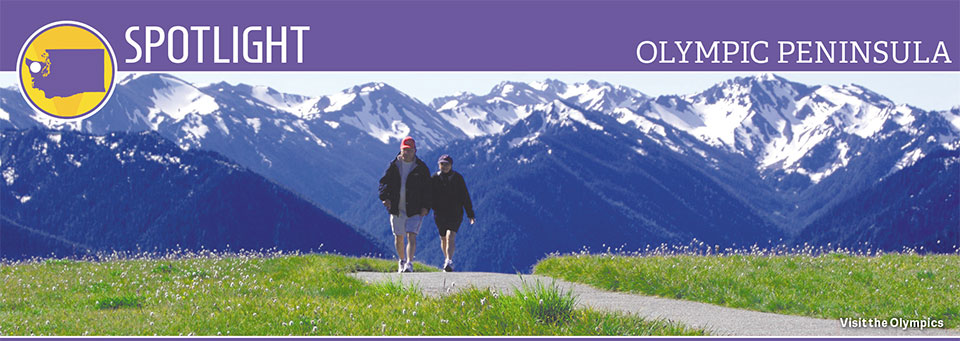Olympic Peninsula
Explore diverse beaches and landscapes in a wilderness wonderland
Whether taking a ferry or making the drive, the Olympic Peninsula is worth it all. Majestic mountains, awe-inspiring oceanfront, verdant rainforests—even elk named after a U.S. President—are among the wonders visitors will find when exploring this northwestern corner of Washington State.
The Last Frontier of the Lower 48
Historians say that Washington’s Olympic Peninsula is the last western frontier of the continental U.S. to get the attention of explorers. One could argue that they saved the best for last: when trying to describe the Olympic Peninsula, “breathtaking” is close but still an understatement. Within its 3.5 million acres is Olympic National Park, replete with rainforests, ocean coastline and the Olympic Mountains, crowned by the jewel known as Mount Olympus. Step outside the park and discover Olympic National Forest, encompassing thousands of acres of greenery, canyons and nature trails, which lead to everything from waterfalls to fantastic views of Lake Quinault.
The region’s human habitation deserves equal attention. In 1977, an unsuspecting farmer digging a pond just outside Olympic National Park discovered the remains of a mastodon—and the spear-like instrument used to take it down. This discovery, dating back some 12,000 years, is among the earliest evidence of the first inhabitants of the area. Today, eight Native American tribes considered descendants of these ancient hunters continue the culture and traditions that link them to the land and surrounding nature of Olympic Peninsula.

Getty Images/iStockphoto
A National Park on the Ocean
Exemplary diversity best describes Olympic National Park. In addition to boasting 73 miles of coastline along the Pacific Ocean, the park also is home to the nearly one million acres of the Olympic Wilderness, an area that comes under special protection from the National Park Service. The area’s diverse landscapes include rainforests, wildlife, nature trails and historic attractions. In short, there are plenty of first-time adventures waiting to be discovered.
One of those adventures on offer is whale watching. Gray whales are known to navigate the coastal waters of the Olympic Peninsula while traveling to their summer feeding grounds up North. The park’s coastline also is marked by beaches, rocky headlands and tide pools, the latter serving up rare glimpses of rainbow-colored sea urchins and other ocean creatures.
Nearby, the Olympic Coast National Marine Sanctuary is the place to view sea lions, seals and other marine mammals at home in the waters of an area spreading more than 3,310 square miles.
Presidential Mammal
Named after intrepid President Theodore Roosevelt, the large and powerful Roosevelt Elk makes its home on the peninsula. The best place to spot this beast is in the park’s Hoh Rain Forest, where the mammals enjoy breakfast, lunch or dinner among the rain forest’s ferns, shrubs and lichens. Roosevelt himself established his hoofed counterpart as a protected species in 1909.
Welcoming Communities
The Olympic Peninsula’s towns invite visitors to stay awhile. Located on the northwest side of the peninsula about 15 miles east of the Pacific coast, Forks is a great basecamp for exploration of the inland forests. With its mystical ambience and idyllic forested landscape, the Forks area is known as the setting for the “Twilight” movie franchise. For visitors, Forks serves as the launchpad for wilderness trails beneath the lush green canopy of the Hoh Rainforest, one of the finest remaining examples of temperate rainforest in the United States. On the coast, at the western edge of Olympic National Forest, La Push is one of the top surf spots on Washington’s coastline.
If surfing’s not your thing, you can enjoy the hospitable community and its marina, from which fishing charters operate in season. Second Beach, just east of LaPush, is popular among photographers and sightseers. This shore is reached by way of a .7 mile forested trail. The reward for the hike? A 2-mile-long stretch of beach, with beautiful seastacks that call out to be photographed. In the fall, mushrooms grow alongside the trails under the forest canopy.
About 28 miles north of Forks, the town of Clallam welcomes travelers with succulent seafood and dazzling views of Clallam bay. Get great photos posing near the statue of the area’s mascot, Rosie the Walking Fish, which overlooks the bay from the nearby town of Sekiu.
East of Clallam, on the peninsula’s north coast across from Victoria, Port Townsend brims with innovative restaurants and eclectic stores. In addition to a great atmosphere, Port Townsend specializes in serving up excellent seafood, cheeses and desserts, and its proximity to great recreation adds to its appeal.
Port of Angels
Port Angeles, on the Peninsula’s north coast directly across from Victoria, provides some of the the best whale watching opportunities in the area. From mid-May to October, a number of outfitters operate whale watching tours that explore this remote wilderness. Most tours offer sightings of the Minke, transient orca, resident orca, humpback and gray whales that find sanctuary in the waters off the town’s coast. West of Port Angeles, lush forests and breathtaking mountains envelop the shores of the otherworldly Lake Crescent, a crystal-clear, 624-foot-deep lake.

Getty Images/iStockphoto
The “Not to Miss” List
While the list of “must-see” attractions in and around the Olympic Peninsula is tough to narrow down, there are some that you simply can’t miss. Hurricane Ridge is among the most popular because of its great vistas of the Olympic Mountains and variety of trails with, panoramic vistas of the Strait of Juan de Fuca.
A 40-minute drive from the Olympic Park Visitor Center in Port Angeles will get you to the summit, but you may want to grab a view from one of the many scenic pullouts along the way.
It’s hard to resist the deep, turquoise-blue waters of Lake Crescent, a glacially carved lake offering a cool, idyllic spot for swimming, boating, camping and, naturally, fishing. Nestled along Highway 101, Lake Crescent also has several beaches and a trail leading to a swimming favorite known as Devil’s Punch Bowl. Jumping off the low, arching bridge that spans the water here is a favorite pastime. Another trail leads to Marymere Falls, one of 26 waterfalls along the Olympic Peninsula Waterfall Trail.
One of the largest cascades along the trail, Sol Duc Falls is found in Olympic National Park. Visitors here might also catch a glimpse of bald eagles that often soar overhead. Catch a quick fish dinner at the Salmon Cascades, where salmon run every season. Trout and steelhead run the river in the fall.
Mt. Walker, on the eastern side of Olympic National Forest, provides unmatched views of Puget Sound, Mt. Rainier, Mt. Baker and the Cascades. The summit road begins a few miles south of Quilcene (near the Hood Canal) on Highway 101.
Shipwreck casualties of the 1900s are memorialized near Rialto Beach, whose rugged ocean coastline offers glimpses of what old-time mariners faced trying to navigate the unique landscape created by rocky offshore islands . Further inland is the Mora area, defined by towering trees, lush greenery and, of course, the sounds of the ocean roaring in the background.
For More Information
Olympic Peninsula Tourism Commission
800-942-4042
www.olympicpeninsula.org
Washington State Tourism
800-544-1800
www.experiencewa.com







